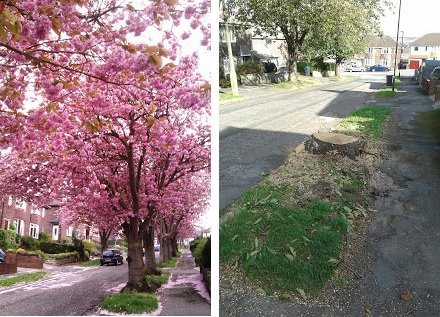
Sheffield Tree Felling:
27th January 2016
Marilyn Monroe: Trees give me a little hope
19th March 2016Neuro-Arboriculture: Your Brain On Trees.

Most tree problems are fairly straightforward to solve: the rooting environment can be improved, branches can be pruned or braced, and trees can be felled and replaced. It becomes much less straightforward when you add people. Deep-seated, even hard-wired emotions define people’s interactions with trees. However, the neurological basis of people’s connection to trees remains a mystery.
Research on the economic and environmental benefits of urban trees has amassed. It shows how urban trees reduce pollution, mitigate extreme weather events, reduce crime, increase property values, encourage retail activity and social cohesion, as well as confirming the long held intuitive belief that trees are good for human health and wellbeing. Despite the value and benefits of urban trees, the uncomfortable fact is, the evidence is often falling on deaf ears. When decision makers have to balance the books, removing trees, or not planting and maintaining them, is still seen as a sensible cost-saving option. Despite the widely advertised economic value of trees, the most important factor influencing a decision makers urban tree management policy is often public reaction. And the public value nearby trees. Not because of what the latest research has to say about the environmental and societal benefits, but because of how trees make them feel.
The last decade has seen an explosion in the field of cognitive neuroscience and cognitive psychology. Whether we know it or not, it influences most aspects of our lives, from education, economics, politics and our personal relationships. Neuroscience has begun to understand how our unconscious, hard-wired emotions impact almost all decisions we make. What if arboriculture was able to use this knowledge? Imagine if new a branch of knowledge could connect neuroscience and arboriculture: “neuro-arboriculture” – designed to understand the links between brain and tree. Neuro-arboriculture could help understand what motivates some people to care about trees, why some feel indifferent, or why people are hostile to trees. It could help encourage people to value and engage with trees in their towns and cities, and it could help arboriculture finally move up the political agenda. Ultimately neuro-arboriculture could help us understand the profound and ancient connections between people and trees.
As a relatively young discipline, arboriculture has understandably been anxious to be seen as legitimate science, and this meant a bias towards studying the more tangible and measurable aspects of tree management. Yet the separation between emotion and science is an outdated notion. Neuro-arboriculture – the neurological underpinning of the aesthetic and experiential value of trees to people – should be seen as fundamental, and this knowledge may become crucial if we are to preserve the urban forest. The role of an arboriculturist is changing. No longer simply a custodian of trees, increasingly they are the interface between people and trees. Perhaps in the next century the most useful new discoveries in arboriculture will not be found looking within tree roots, cambium or foliage, but within the human mind.
Read more…
Read more…






1 Comment
Great piece! Changing the narrative around arboriculture will require us to challenge existing dogma and embrace things we are only beginning to become conscious of. Keep up the blog. These exercises in cerebral fitness will undoubtedly can do no less than prepared future arborists to work on human-tree connections we had never considered.